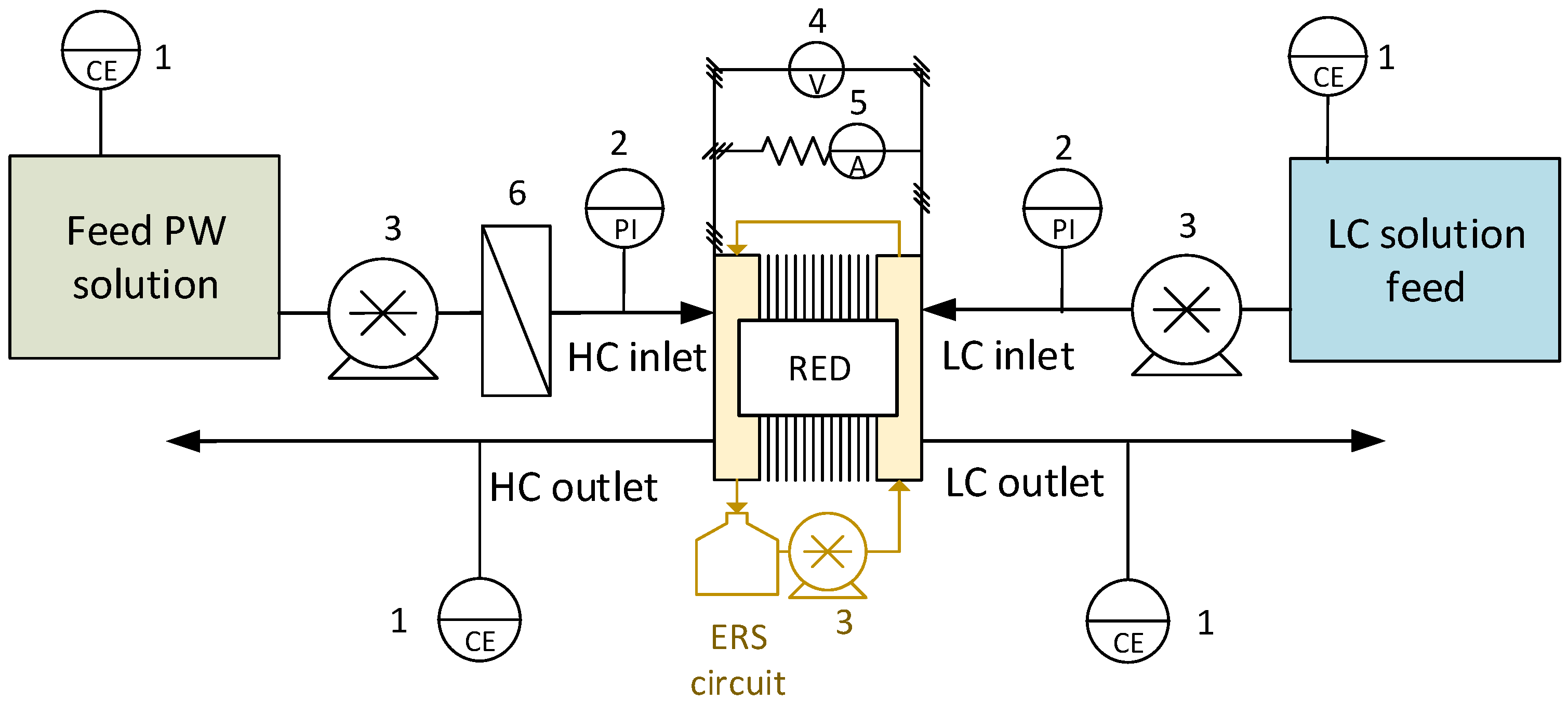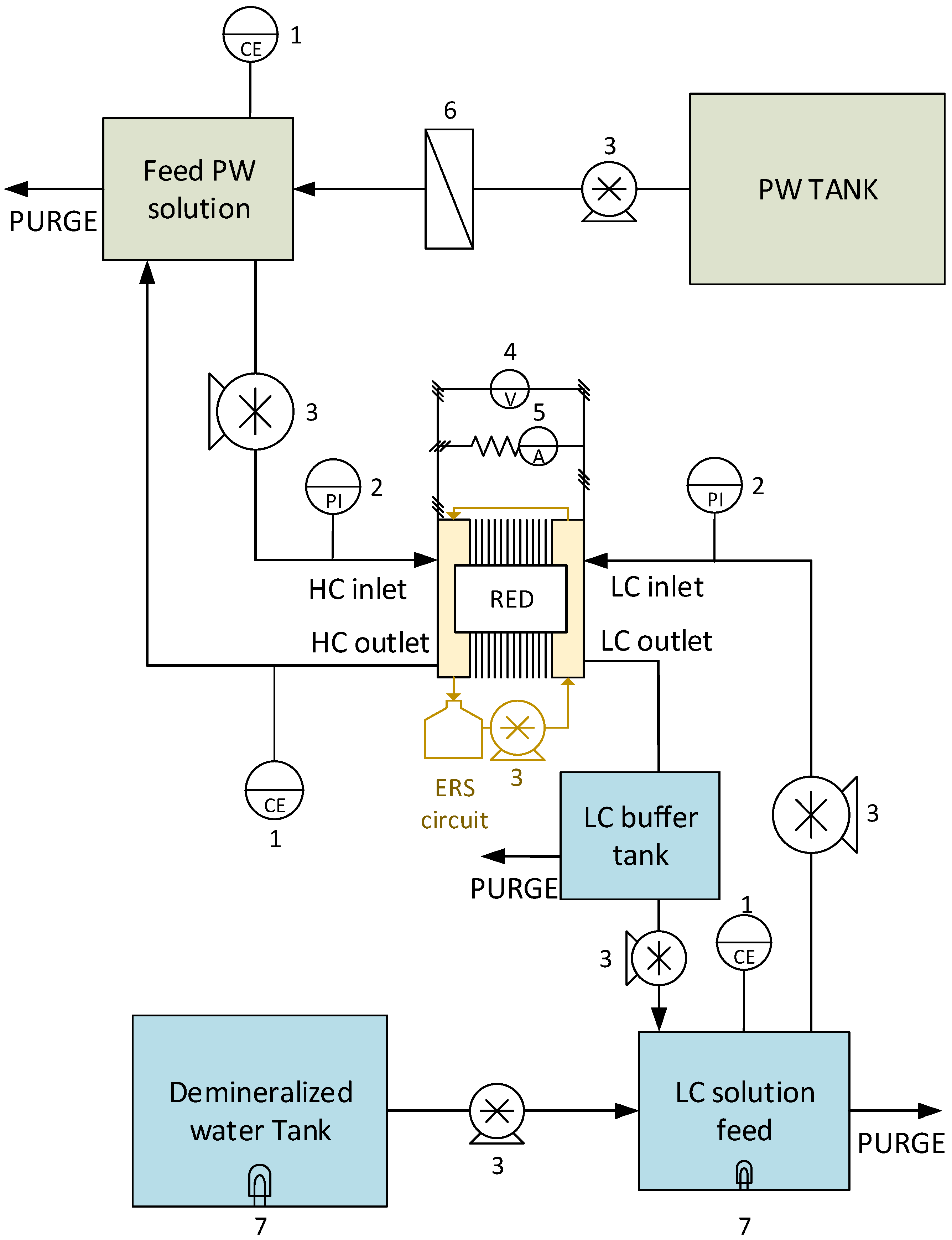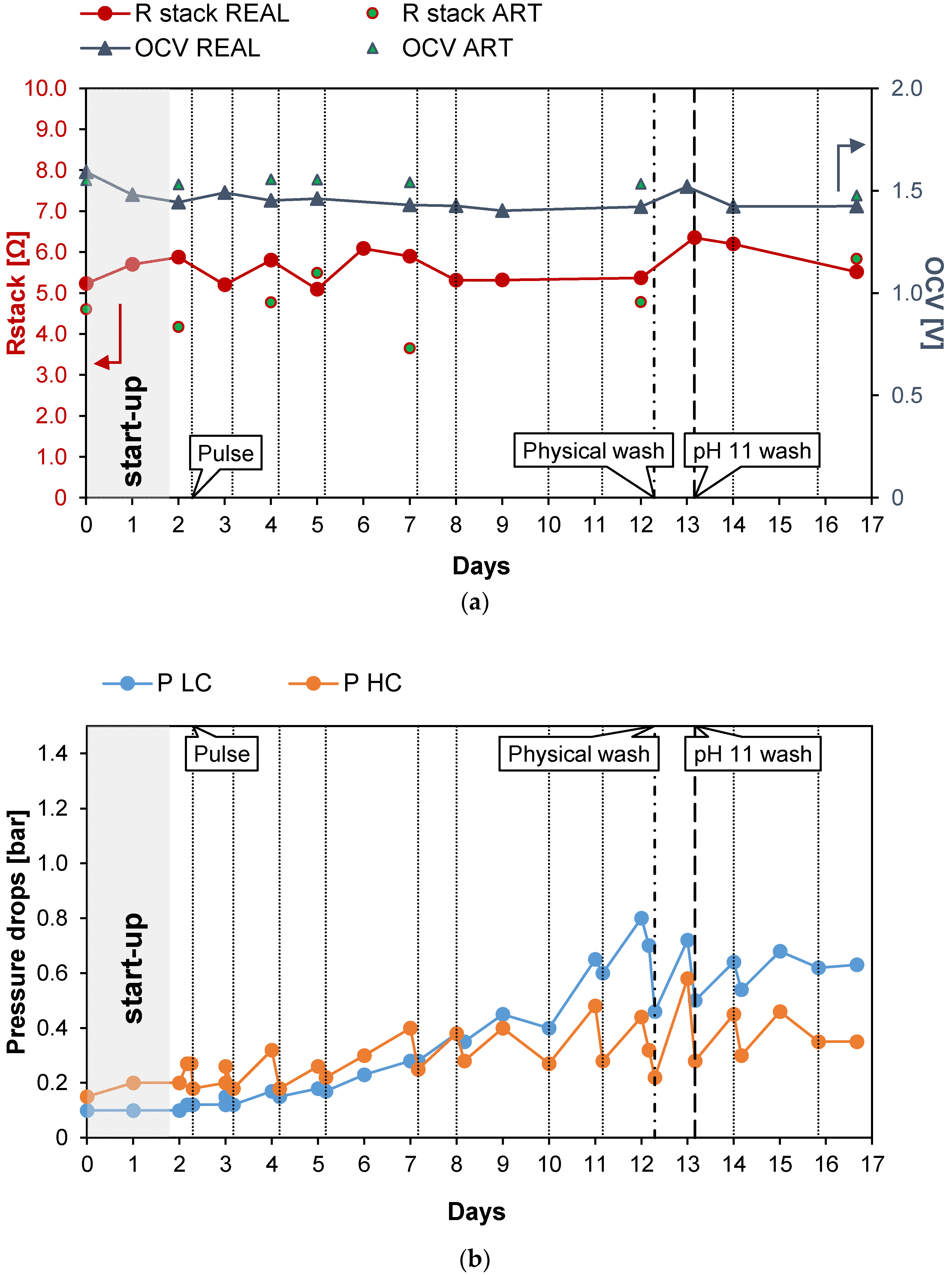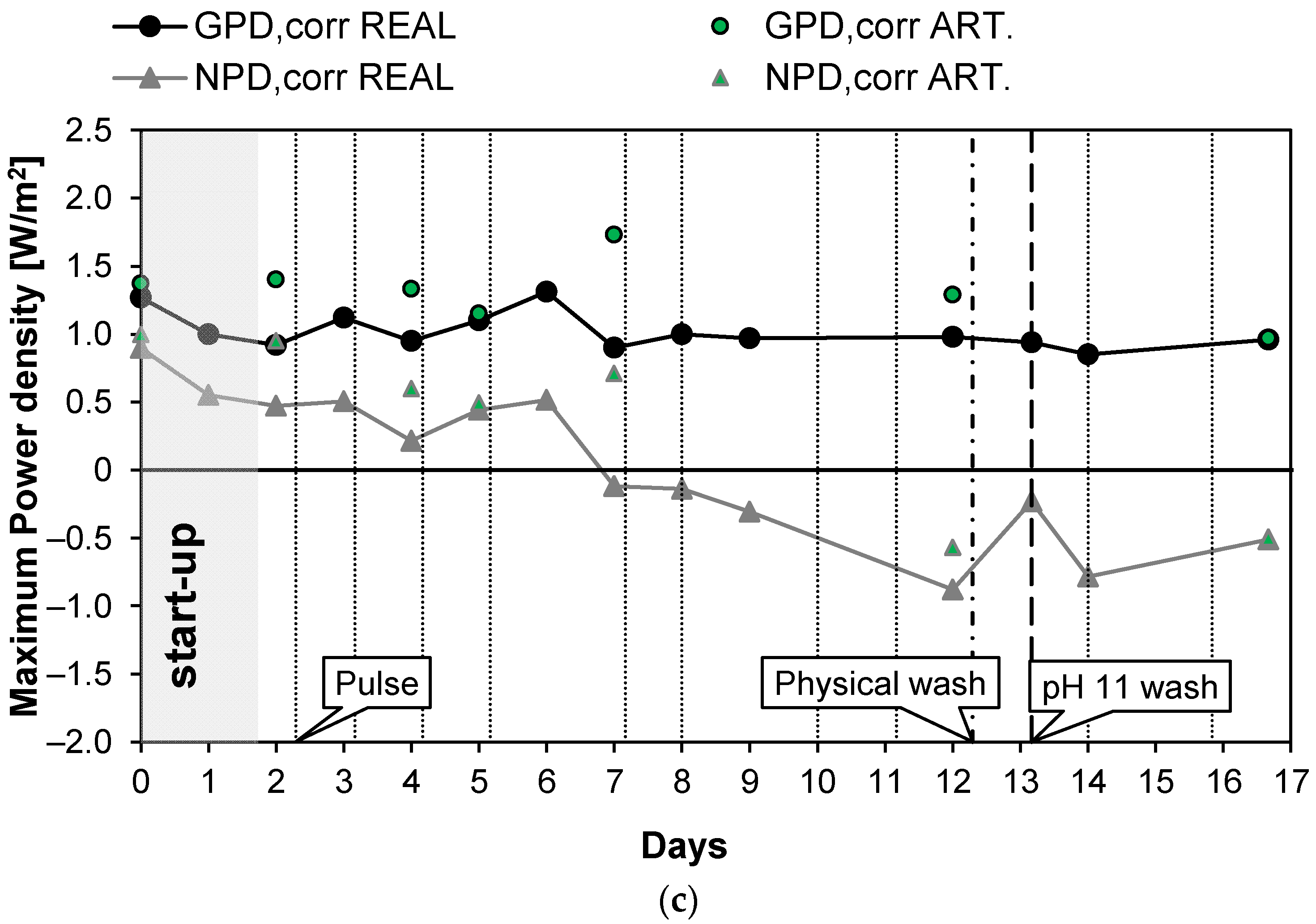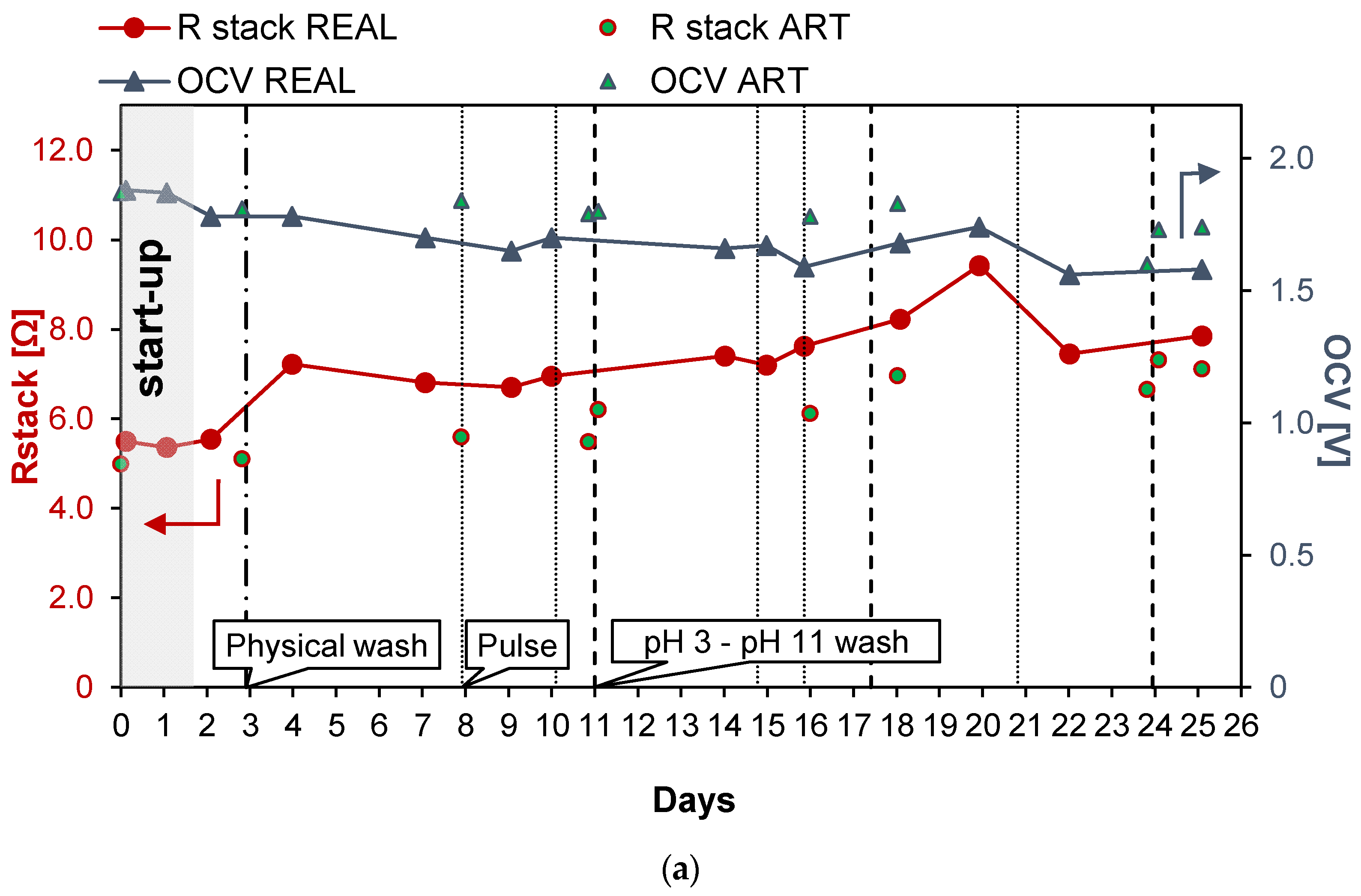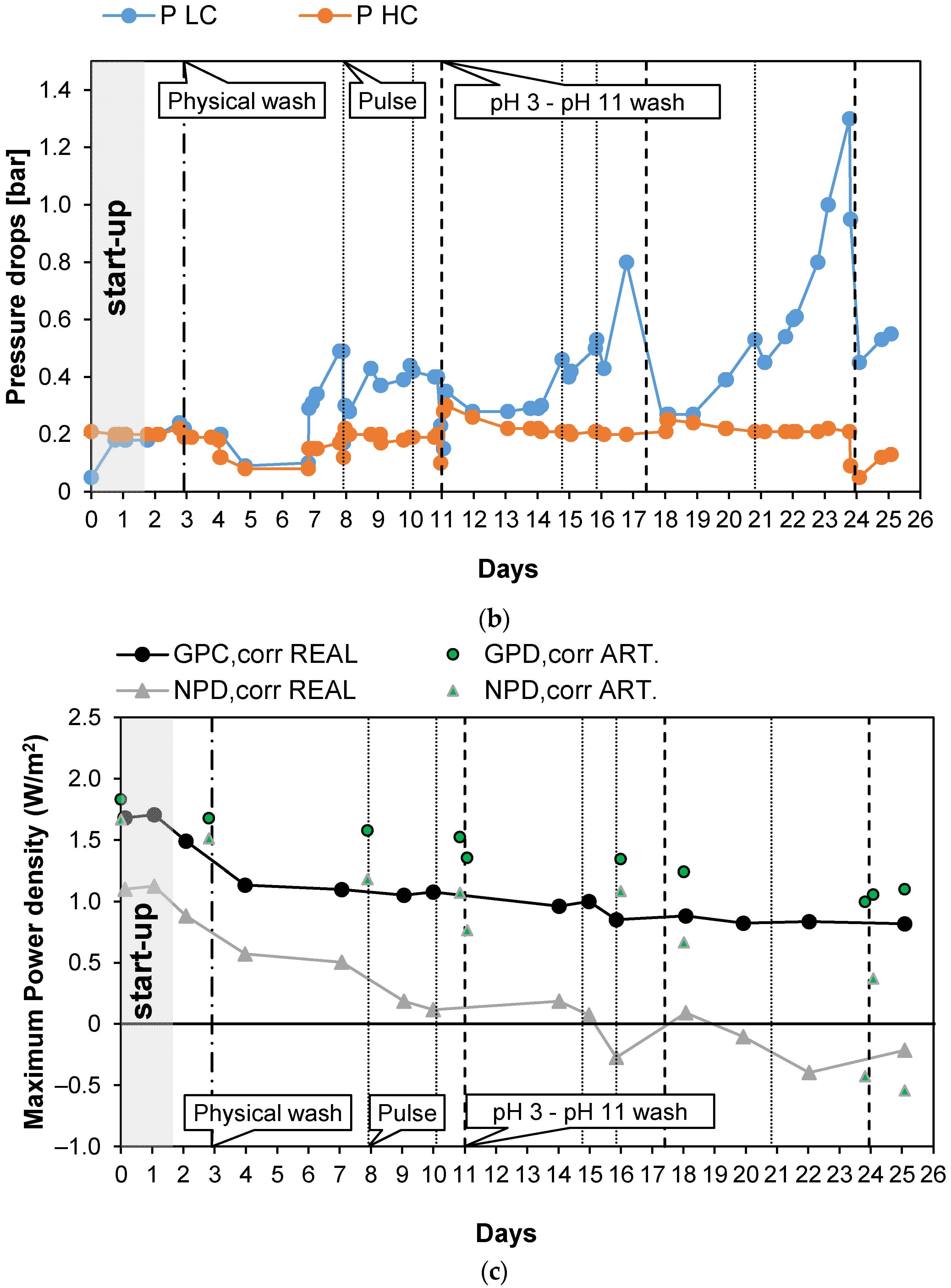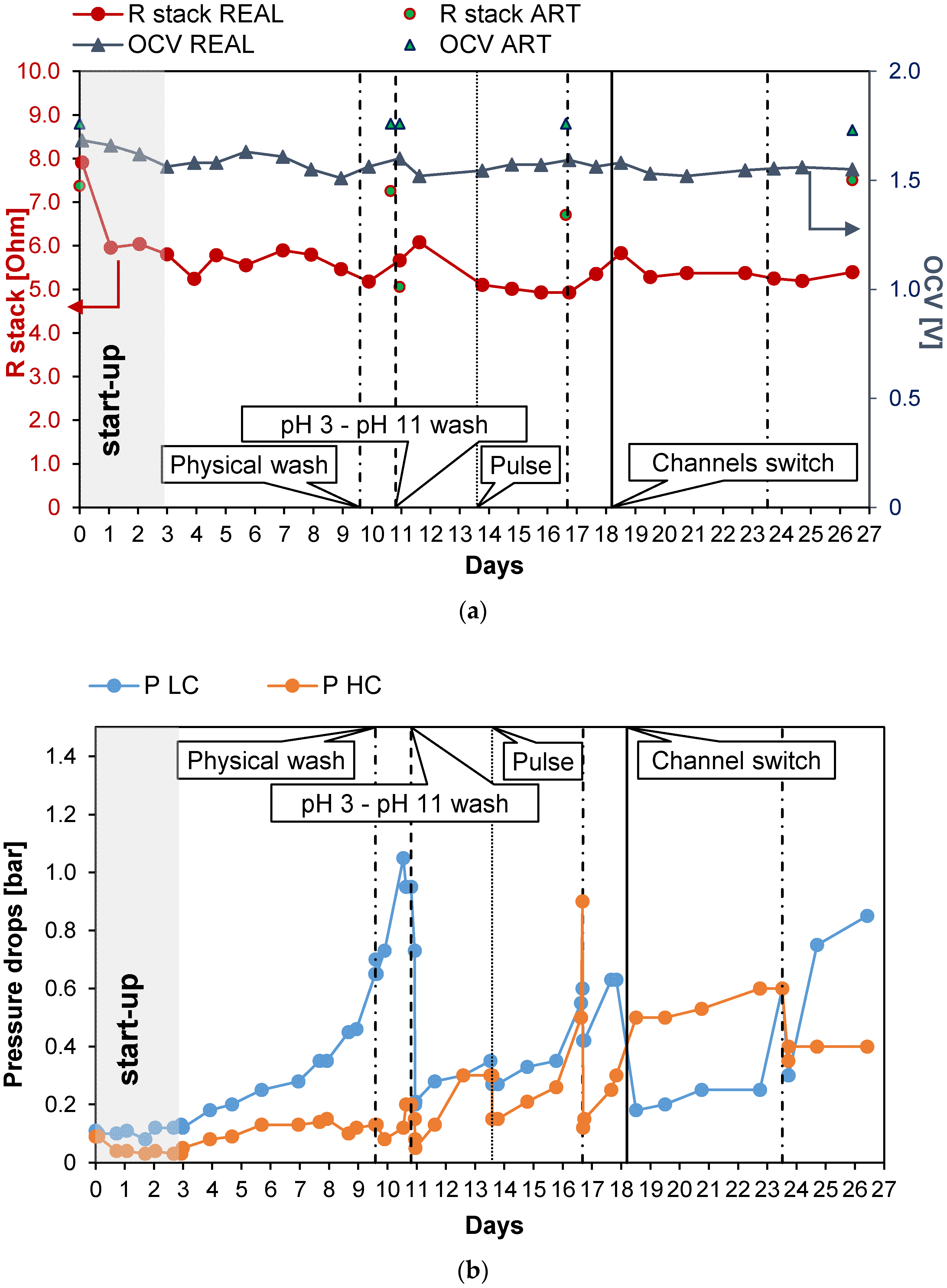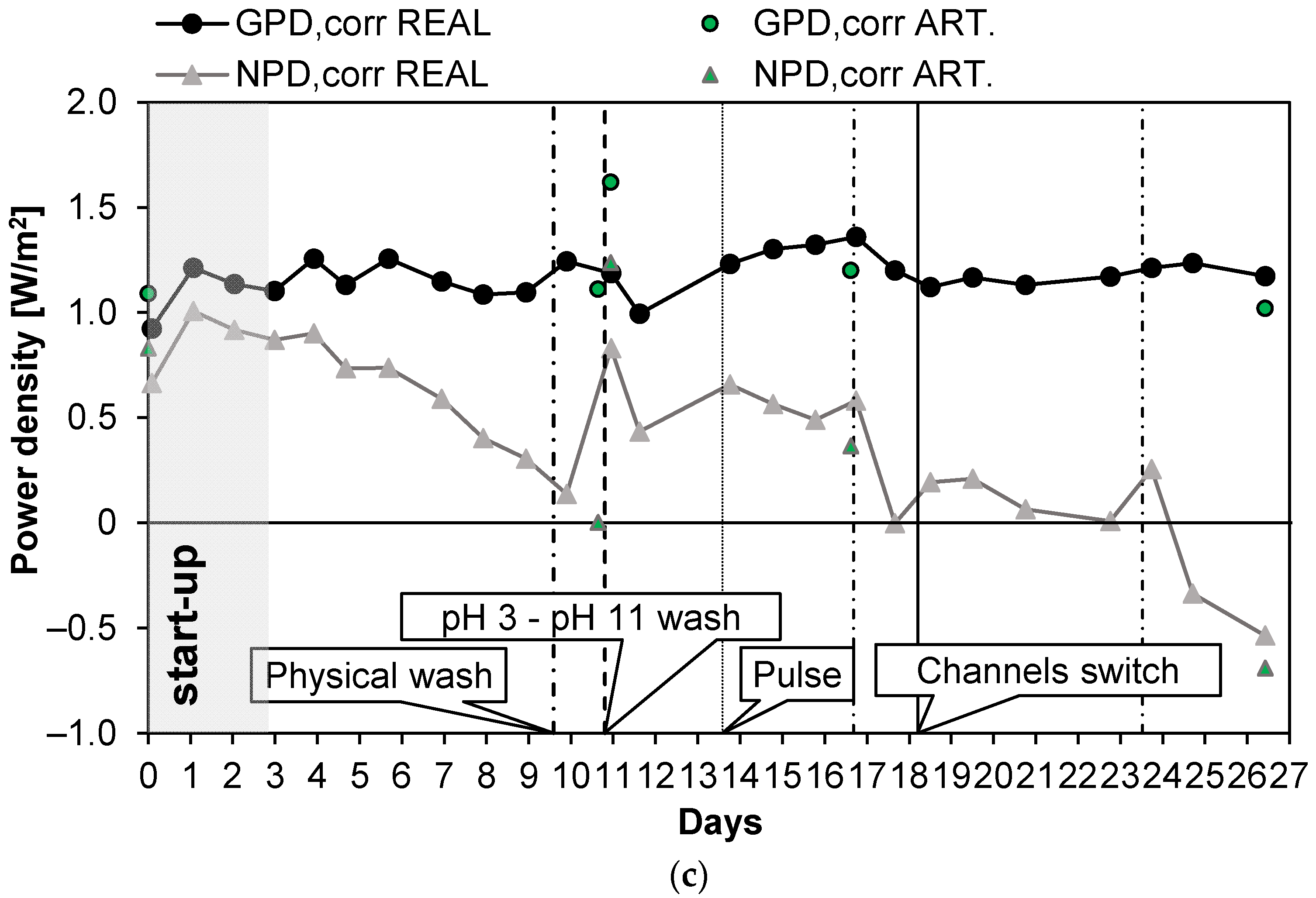1. Introduction
Produced waters (PWs) are a waste stream obtained as a by-product during the extraction of fossil fuels from on-shore and off-shore wells. These solutions include both the formation waters trapped over millions of years in geologic reservoirs with fossil fuels [
1] and the injection water [
2,
3] used during the oil extraction operations to enhance the oil recovery, often carried out using seawater, brines, or fresh waters.
PWs can present very different features, mostly depending on the field location and production process. The main components of PWs can be classified as:
Dispersed oil: coming from crude oil and present as micro drops;
Dissolved organics: soluble components present in the crude oil;
Solid particles: extracted with the water or deriving from scaling phenomena;
Dissolved minerals: strongly dependent on the location of the oil well; they can be heavy metals;
Chemicals: additive injected during the crude oil production (corrosion and fouling inhibitors, emulsion breakers, etc.);
Dissolved gases: mostly volatile hydrocarbons, CO2, O2, and H2S.
A summary of the common properties of PWs reported in the literature is shown in
Table 1 [
4,
5,
6].
PWs can have very large ion contents, with the total dissolved solid (TDS) ranging between 0 and 300 g/L (see
Table 1), which is mainly represented by the same ions contained in seawater [
7].
The volumes of this wastewater are prominent and have been growing in the last decades [
8]. Generally, the water oil ratio (WOR), i.e., the volume of produced water with respect to the oil extracted, is approximately 3:1 [
9,
10]. In 1990, the production of PW was about 190 million barrels per day while, nowadays, it has reached ~320 million barrels [
2]. Currently, PWs are reinjected into the extraction wells, discharged into the sea, or sent to evaporation ponds, thus resulting in significant environmental issues [
11]. The disposal of PWs represents a significant additional cost in the management of an oil well, ranging between 5% and 19% of the total capital cost [
12].
Several works have studied different alternatives to the PW disposal considering the possibility of managing and reusing such streams. Among them, some interesting processes have been proposed, for example, the treatment chain proposed by Wenzlick and Siefert for generating brine and clean water [
12] and the valorization process proposed by Seip et al. for recovering lithium using manganese-based sorbents [
13]. The complexity of PWs makes their treatment very difficult. In particular, the nature of dissolved and dispersed components causes fouling phenomena in the membrane processes [
6,
14], thereby hindering their adoption. Moreover, the high salinity of the PWs is detrimental to conventional bio-remediation treatment processes [
15].
Conversely, the high salinity is an advantage for salinity gradient power (SGP) technologies, which produce green electricity by mixing PWs with more diluted streams (e.g., process water or side-waste streams), thus reducing the treatment costs.
SGP technologies are based on a controlled mixing process of two solutions with different salinity that collects the Gibbs free energy of mixing, which is dissipated during a normal mixing process of such solutions. The main studied technologies used to harvest energy from salinity gradients are (i) pressure retarded osmosis (PRO) and (ii) reverse electrodialysis (RED) [
16,
17,
18]. The latter is based on the use of ionic exchange membranes (IEMs), which have been proven to be less prone to fouling than osmotic membranes [
19]. This may represent a crucial advantage for managing PW streams that are rich in foulants.
Sites where PWs are generated may strongly benefit from the harvest of salinity gradients by RED. PWs are commonly reinjected into extraction wells (after the separation from hydrocarbons) without treatment. Electricity could be harvested from them via RED before reinjection. In addition, or as an alternative to this, RED might be used to reduce the salinity content of the PWs, thus enabling the adoption of conventional or advanced biological-based treatment processes. The option of electricity production might only be easily implemented in onshore plants if a stream with a lower salinity is available. It might also be implemented at offshore sites where seawater can be used as the dilute stream, although the feasibility will be strongly affected by the lower salinity gradient available, and the relevant larger membrane area required. The second option of combined electricity production and a concentration reduction for further treatments might be more suitable for onshore plants than existing offshore plants due to the lack of room available. Clearly, independently of the option adopted, a preliminary thorough analysis will be mandatory to assess which ions and, more importantly, which pollutants can pass through the IEMs, thus moving from the PW to the dilute stream. Reverse electrodialysis has mainly been proposed and designed so far for the production of electricity using seawater and river water. During the last years, many improvements have been achieved in laboratories using artificial seawater (~30 g/L NaCl) and river water (~1 g/L NaCl) [
16,
20,
21]. The RED technology was also tested with non-conventional solutions, such as artificial solutions of ammonium bicarbonate [
22,
23], human urine [
24], or with poly(sodium 4-styrenesul- fonate) (NaPSS) added to the dilute solutions to increase the conductivities and enhance the power outputs of the RED cells [
25]. Several studies were devoted to investigating the effect of the channel thickness [
26], temperature [
27], and fouling phenomena [
28,
29,
30,
31,
32].
Data has been collected so far, with experimental campaigns adopting real feed solutions. In particular, in 2012, Vermaas et al. [
33] studied the behavior of RED stacks, equipped with five cell pairs and fed with natural seawater and river water for 25 days. During the tests, a marked increase in pressure drops and a corresponding decrease in the net power density of about 40% (occurred after the first day) were reported. Similar experiments were carried out by Avci at al. [
34] in 2018 using streams collected from Licetto River and Tyrrhenian Sea. A power production decrease of ~40% with respect to the system fed with artificial solutions was found. Recently, Vital et al. [
35] carried out a long-run test (54 days) with natural seawater and fresh water and claimed that suspended particles with an average diameter of 10 μm reduced the gross power density of the system by about 25%.
An interesting low-concentrated stream used in several studies is reclaimed municipal wastewater from treatment plants. In 2018, Nam et al. [
21] presented an experimental campaign on a pilot-scale RED unit consisting of 1000 cell pairs fed by seawater and a municipal wastewater effluent, reporting a power density of 0.76 W/m
2cell pair. In 2020, Hossen et al. [
36] tested a lab-scale unit (5 cell pairs, active area of 64 cm
2) fed with real seawater from three different sites in North Caroline and treated wastewater, finding a maximum power density of 0.50 W/m
2cell pair. In 2020, Gómez-Coma et al. [
37] performed tests with an RED unit (20 cell pairs, active area of 36 cm
2) fed by reclaimed water from a treatment plant and seawater, with both pre-treated. The experimental campaign lasted for 20 days and a maximum power density of 1.4 W/m
2cell pair was reached. No losses in performance were found during the working period, highlighting the need for suitable pre-treatments for the feed solutions. However, the presence of a residual coagulant (such as polyaluminum chloride) negatively affected the RED process because of the increase in the membrane resistance [
38].
New and interesting scenarios are opened by the exploitation of industrial waste brines as high-concentrated feed solution. Few studies have been carried out on the valorization of industrial saline wastewaters as concentrated feed in RED systems. In 2016, Tedesco et al. [
39] tested the first pilot RED (125 cell pairs, active area of 44 × 44 cm
2) system fed with real brackish water and concentrate waste brine from saltworks (named bittern). The RED unit was tested for five months with both natural and artificial feed solutions. The results showed that the use of real feed streams caused a reduction in the power output of about 40–50% (average power density of 2.7 W/m
2cell pair), and a stable behavior with no significant performance losses during the investigation period. Later, two larger units with 500 cell pairs of 44 × 44 cm
2 were installed in the same location and a power output of above 300 W was achieved [
40]. Different bitterns, originating from salt production plants [
41] or reverse osmosis brines from desalination plants [
8,
42], were also used to harvest energy via RED. In 2020, Yasukawa et al. studied the performance of a RED unit fed by bitterns from the salt production plant of Mamizu Pia (Fukuoka, Japan) and sewage-treated water, obtaining a maximum power density of 1.08 W/m
2cell pair [
43]. The high amount of divalent ions in the natural stream is one of the main reasons that led to the performance reductions observed when switching from artificial to real solutions [
8,
44,
45]. Ions that are different from NaCl in the natural solutions may cause a reduction in the
OCV, an increase in the internal resistance, and, thus, a low maximum power density [
46]. Nevertheless, the negative effect of multivalent ions could be mitigated through the use of multivalent permeable membranes [
47]. In 2018, Luque et al. [
48] used a fish canning factory wastewater treated in a biological process and filtered at 5 μm as the concentrated feed solution. It was paired with an urban waste stream treated in a membrane bioreactor (MBR). Implementing a series of anti-fouling strategies during continuous operation in an RED unit of 10 × 10 cm
2, the maximum power output was about 0.66 W/m
2cell pair. Unfortunately, biological fouling is the most frequent phenomena that occurs in low-saline channels. Bacteria colonies, in fact, could grow inside the spacers’ manifolds and on the surface of the membrane and lead to the formation of a biofilm [
6]. This organic matter causes a gradual clogging of the channels and hinders the solution’s passage. As a result, a strong increase in the pressure drops along the channels occurs and the pumping power demand increases. In this scenario, the study of the long-term effects of real feeds in RED units could be crucial for the future development of this technology at a high scale.
Concerning the production of electricity from PWs via RED, recently, Abbas and Al-Furaiji [
49] adopted a synthetic PW (250 g/L TDS as a concentrated stream), a synthetic solution with a concentration similar to seawater (30 g/L as a diluted stream), and reported a maximum power density of 0.029 W/m
2cell pair.
In this work, for the first time to the authors’ knowledge, real PWs were used as concentrated feed solutions to generate green electricity in an RED system. To this aim, an intensive experimental campaign on a lab-scale RED unit was performed using two different real produced waters from oil extraction wells. Long-run tests, for up to 25 days, were carried out by monitoring the time evolution of the main unit performance and the behaviors of the ion exchange membranes subjected to fouling phenomena due to the presence of pollutants in the real produced waters.
2. Materials and Methods
An RED unit is made of several repetitive units called cell pairs, consisting of two channels and two IEMs, i.e., an anion exchange membrane (AEM) and a cation exchange membrane (CEM). Spacers are interposed between the membranes to generate the two channels where a concentrate solution (or high-concentration solution, HC) and a dilute solution (or low-concentration solution, LC) are alternatively fed. The salinity gradient across each IEM generates a potential difference, leading to an ionic flux between the two adjacent solutions. At the two ends of the stack, electrode compartments are placed. In these compartments, an electrode rinse solution (ERS), containing redox couples, is continuously recirculated, allowing the conversion of the ionic flux into electric current when an external load is connected to the RED unit. Between each electrode compartment and the cell pairs, an end-membrane is interposed.
2.1. Feed Solutions
Two different real wastewaters (PW1 and PW2), from two different oil industrial wells located in southern Europe, were studied as the feed solution in an RED unit. After an in-place oil separation treatment, they were used as high-concentration feed (HC). The main features of these solutions are reported in
Table 2 and
Table 3. In particular, PW1 contains a larger amount of ions and organic compounds (i.e., total dissolved solid, TDS = 74.4 g/L and total organic carbon, TOC = 368.3 ± 3.6 mg/L) than PW2 (i.e., TDS = 46.3 g/L and TOC of 109.9 ± 2.9 mg/L).
To analyse the influence of the use of real solutions on the RED unit performance, the two real HC solutions were also artificially reproduced by preparing synthetic solutions that comprised NaCl-water only, mimicking the conductivity of the real solutions (see
Table 3).
All tests were performed by considering as low-concentration (LC) feed solution, a synthetic solution of pure NaCl, and demineralized water with a concentration of 0.7 g/L and a conductivity of 1.49 mS/cm. This concentration value was selected to mimic the typical concentration of process water available in the relevant oil extraction industries. Recrystallized NaCl solid from Volterra (Italy) with a purity of 99.8% and demineralized water with a conductivity lower than 10 μS/cm were used to prepare all the artificial solutions.
2.2. Experimental Set-Up
Two different units were used for the experimental campaign (Stack 1 and Stack 2), both composed of 10 cell pairs with an active membrane area of 10 × 10 cm2. In Stack 1, polyamide woven spacers 300 μm thick, with a silicone gasket (provided by Redstack, Sneek, The Netherlands), were interposed between the ionic exchange membranes. In Stack 2, overlapped spacers in polyamide with a thickness of 270 μm (provided by Deukum, Frickenhausen, Germany) were adopted. The end plates of both units are made of PMMA and two Ru-Ir oxides coated titanium electrodes were located there.
The adopted ion exchange membranes were provided by Fujifilm (Tilburg, The Netherlands) (Type 10 AEM and CEM) while the two end-membranes by Fumatech (Bietigheim-Bissingen, Germany) (Fumasep FKS-50). The main properties, from the technical datasheet provided by the companies, of the membranes are reported in
Table 4.
The membranes, once cut and drilled, were placed for 24 h in a 35 g/L NaCl solution for conditioning. Polypropylene cartridge filters (Water Hi-Tech from Italy Water, Carini, Italy) with decreasing pore sizes (10, 5, and 1 μm) were used to filtrate the two PWs before feeding them to the RED unit.
Two peristaltic pumps (Leadfluid WT/600/S, He Bei Sheng, China) were used to feed the solutions into the stack with a co-current arrangement. Another peristaltic pump (Seko Kronos 50, Rieti, Italy) was used to recirculate the ERS. The two solutions, stored in a tank of 20 L, were fed at a flow rate of about 90 mL/min in Stack 1 and about 80 mL/min in Stack 2. These flow rate values correspond to an inlet velocity of about 0.5 cm/s within the channels (empty channel without spacers). Typically, feed velocities of 1 cm/s are used in laboratory tests for RED systems [
50]. However, the use of real wastewaters may produce significant pumping losses due to fouling and bio-fouling phenomena. An inlet channel velocity of 0.5 cm/s was considered a good compromise between keeping “power losses as low as possible” and worsening the concentration polarization effects.
The electrode rinse solution (ERS) was prepared by dissolving 0.1 moles of K3[Fe(CN)6] (Sigma Aldrich, St. Louis, MO, USA, >99%), 0.1 moles of K4[Fe(CN)6]∙3H2O (Sigma Aldrich, >99%), and 0.58 moles of NaCl (99.8% Sigma Aldrich) in a liter of demineralized water. NaCl was used in the ERS as supporting electrolyte, in such a quantity as to replicate the total concentration of ions corresponding to the average concentration of the two feed solutions (HC and LC).
Alkaline (pH = 12) and acid (pH = 3) solutions for the chemical cleaning were prepared with demineralized water and sodium hydroxide (solid NaOH > 99%, Sigma Aldrich) and hydrochloric acid (HCl 37%, Sigma Aldrich), respectively.
The ion concentration was determined by ion chromatography analysis, carried out with a Metrohm 822 Compact Plus IC equipped with the cation-exchange Metrosep C4 and the anion-exchange Metrosep A Supp 5 columns (Herisau, Switzerland). Pressure transducers (VEGA-14, Assago, Italy), placed at the inlet of the two channels, were used to monitor the pressure drops inside the stack. To measure the conductivity and pH of the solutions, a portable WTW Profiline pH-Cond 3320 conductivity/pH-meter, equipped with a TetraCon 325 conductivity cell and a SenTix 41pH electrode (from Xylem, Weilheim in Oberbayern, Germany) was used. An electronic load (BK8540, B&K Precision, Yorba Linda, CA, USA), connected to the RED electrodes, was used to close the external electric circuit. Two multi-meters (Fluke 175 True RMS, Everett, WA, USA) were used for measuring the voltage and current. Two 0.5 W UV lamps (Aquael UV, Suwalki, Poland) were used in each LC solution reservoir during some tests, along with a recirculation submersible pump (Prodac Pump 200, Cittadella, Italy) working at 100 L/h.
The main specifications of the test-rig instruments are reported in
Table 5.
2.3. Experimental Procedures
The performance of the system was investigated firstly with short-time spot tests (a), and subsequently, in continuous operations, with three different long-run tests with a time duration of up to 26 days (b).
(
a) In the spot tests, the RED unit operated in once-through mode with fresh solutions continuously fed to the system. To highlight the impact of using real PWs, the performance of the system was first evaluated by feeding the stack with the artificial solutions and, secondly, with the real HC solutions. To this aim, the conventional procedure used to characterize the RED unit performance in terms of current/voltage and power density/voltage curves [
16,
20,
23] was adopted. The RED unit was connected to the external electronic load, which stepwise varies the value of the external resistance from the open-circuit (OC) to short-circuit (SC) condition, measuring both the stack voltage (
E) and current (
I). The open circuit voltage (
OCV) is defined as the electrical voltage of the stack in the OC condition. The electrical resistance of the stack (
Rstack) is inferred from the slop of the
E vs.
I linear trend. The product of
E times
I gives the generated gross power of the system (
Pgross, see Equation (1)). The gross power density (
GPD, Equation (2)) curve is obtained by normalizing each value of the power for the number of cell pairs (
N) and the active membrane area (
A):
The maximum gross power density value of the
GPD vs.
E curve corresponds to the condition in which
E ≈
OCV/2, i.e., when the stack internal resistance
Rstack is almost equal to the external load. The net power density value (
NPD, Equation (3)) includes the pumping losses directly related to the pressure drops inside the stack:
where
Ppump is the total power required for the pumping of the two streams inside the RED unit.
Ppump is calculated by Equation (4):
where
and
are the overall pressure drops in the RED unit along the concentrated (
HC) and diluted (
LC) channels, respectively, while
and
are the corresponding volumetric flow rates.
The power density values evaluated using a small lab-scale unit constituted by few cell pairs are strongly influenced by the blank resistance (
Rblank). The latter is the contribution to
Rstack given by the electrical resistance of the electrode compartments (more specifically, given by the (i) electrode rinse solution, (ii) electrodes, and (iii) one end-membrane). When stacks with a high number of cell pairs (larger than 100) are considered, the influence of
Rblank might be neglected with respect to the resistance of the cell pairs, which provides the greatest contribution to
Rstack. The
Rblank can be evaluated through the physical measurement of the electrical resistance of the unit assembled with only one end membrane and fed with only the electrode rinse solution. An
Rblank value of about 0.27 Ω was found in our system. Thus, to evaluate the power density of scaled-up units, the so-called corrected (gross) power density (
GPD,
corr) is evaluated by subtracting the blank resistance from the resistance of the stack [
22]. Similarly, the net correct power density (
NPD,
corr) can be easily calculated from the
GPD,
corr (see Equation (3)) by subtracting the pumping power density.
The average permselectivity of the IEMs is evaluated by comparing the experimental
OCV with the theoretical
OCV according to Equation (5):
In particular, the theoretical
OCV is evaluated by using the Nernst equation [
51,
52]. A schematic representation of the once-through configuration of the test rig is reported in
Figure 1.
(b) The long-run tests were performed using PW1 and PW2 as HC and the artificial NaCl solution as LC arranged in steady concentration mode. In this configuration, the concentrations of the feed solutions are kept at a fixed constant value by considering a feed and bleed arrangement, i.e., a partial recycle system, with a ratio of purged solution. In other words, an equal amount of solution is continuously purged and made-up. A transition period (start-up) is required by the system in the first days of the test to reach the steady condition. During this period, the PW in the feed reservoir leads the concentration to the fixed value while the membranes are adapting to the new operating conditions. The purpose of working in the steady concentration mode is to simulate in a lab-scale unit, a portion of a hypothetical industrial system constantly operating with the same concentration of the feed solutions. The equivalent NaCl concentrations of the HC in the different tests performed at a steady concentration were kept constant at 25.7 g/L during the long-run I, at 50.3 g/L during the long-run II, and at 29.8 g/L during the long-run III. Similarly, in all the tests, the LC solution was maintained at a fixed concentration, i.e., 0.7 g/L, using a similar feed and bleed arrangement, which reduced the consumption of demineralized water.
During the long-run operations, the RED unit was connected to a fixed external load. The value of the external electrical resistance was chosen to operate the system around the maximum power density condition. During the experiments, the performance of the system was tested using the spot test procedure (
a), evaluating the temporal variation of the power density, the stack resistance, and the pressure drops. This guaranteed monitoring of the conditions of the IEMs exposed to fouling issues. A schematic representation of the test rig is reported in
Figure 2.
In the present work, three different long-run tests were performed to study the performance of RED units fed by real PWs.
In the long-run test I, the RED unit (Stack 1) was operated in steady concentration mode; thus, both PW1 and the artificial LC are posed in a feed and bleed fashion. The concentration of PW1 was fixed at an equivalent concentration of about 25.7 g/L. For this test, Stack 1 operated for about 17 days and to counteract the fouling phenomena, some anti-fouling actions were performed. When pressure drops were too high, the flow rates of the two-feed solutions were impulsively increased from the normal value (i.e., 80 mL/min) to 1600 mL/min, for about 2 s. In other words, a “pulse” in the flow rates was carried out to aid the removal of substances clogging the channels out from the unit. This operation was repeated 3–6 times, until a reduction in the pressure drops was observed. Moreover, physical or chemical washes were adopted. When the pulses started to not be effective, a physical counter washing was carried out by switching the inlet and the outlet and increasing the flow feed flow rate at about 800 mL/min for 10 min, thus allowing the cleaning of channels in the opposite direction with respect to the normal operative condition. After the washing, the stack was set to the standard inlet/outlet configuration. The chemical washing of the system was carried out by stopping the normal operation and feeding, for a few minutes, NaOH solutions (pH = 11) in the channels. The washing operation was completed when no variation between the inlet and the outlet values of the pH was obtained, and then, a washing of the channels with demineralized water was performed before restarting the test with the nominal feeds.
In the long-run test II, Stack 2 was operated for 25 days as in the previous long run but with the concentration of the inlet PW1 fixed at an equivalent concentration of about 50.3 g/L. The chemical washing of the system was carried out using both acid and alkaline solutions (solutions of HCl, pH = 3, and NaOH, pH = 11, respectively). In addition to the previous antifouling strategies, a UV lamp was installed in the LC tank to avoid bacteria and algae proliferation.
In the long-run test III, Stack 1 was operated for 26 days using PW2 at an equivalent concentration of 29.8 g/L and the artificial LC as feeding solutions both in the feed and bleed configuration. In addition to the previous antifouling strategies, the channel switch was also considered. To this aim, the HC was sent in the LC channels, and vice versa, to modify the habitat of any bacteria colony eventually formed inside the channels.
A summary of the main conditions and antifouling strategies adopted in the three long-run tests are reported in
Table 6.
4. Conclusions
This work represents, to the author’s knowledge, the first work in which real produced waters were used as feeds in RED units to produce energy. Three long-run tests were carried out with two kinds of produced waters, originating from two different sites. The membrane’s properties (electrical resistance and permselectivity) seemed to be poorly affected by the presence of pollutants and minority species in the produced waters. Interestingly, the results showed that it is possible to produce energy from produced waters, and valorize such industrial wastewater using in situ operations via RED systems. The maximum power density obtained was about 2.5 W/m2, which is perfectly comparable to values reported in the literature for streams with similar salinity gradients and, overall, similar to those obtained with artificial solutions. Indeed, when membranes and channels are still clean, no important losses of efficiency due to the pollutants contained in the feed were observed. The membranes, after an initial period of conditioning, presented an electrical resistance that increased slightly over time. The main issue is represented by the fouling, in particular, channel clogging, which is probably due to bacteria growing in the channels of the RED unit and in the dilute solution circuit. The use of anti-fouling actions, such as the use of chemical washes and physical counter washes, allowed the RED unit to be continuously operated for about 25 days. However, negative values of net the power density occurred after a few days of operation. As a result, the coupling of UV lamps and acid-alkaline washes ensured positive power density values until the 18th day. In particular, it was observed that the UV lamps prevented bacterial proliferation in the LC solution and the consequent clogging of the RED unit channels by the bacteria colonies. In fact, the problem of bacteria growth mainly occurred in the LC solution, since the high concentration of salt in the brine depressed the activity of the bacteria. Moreover, the long storage time of solutions in the laboratory promoted the growth of bacteria. This is expected to be less dramatic in industrial processes, where continuous solutions are fed to the system. Benefits may come from a continuous switching of the solutions (e.g., once per day or per hour). Moreover, other additional methods could be implemented, for example, the use of periodic ED pulses that prevent the adsorption of pollutants on the membranes’ surface, thus keeping the stack resistance constant.
Overall, there is still room for further improvements and anti-fouling strategies still need to be carefully integrated and tuned. On the other hand, the preliminary collected results are quite promising and suggest that the use of saline waste streams in RED systems may lead to new scenarios for the application of such systems in industries and treatment plants, enlarging the potential of the salinity gradient power.
